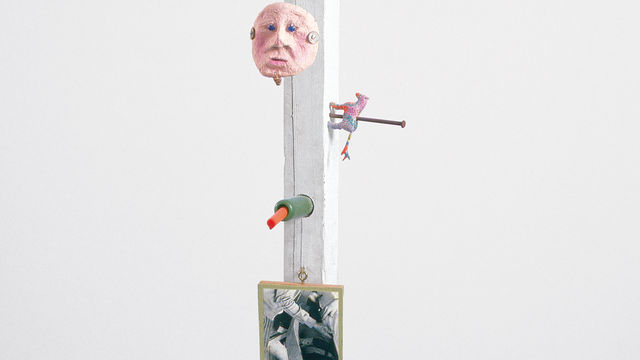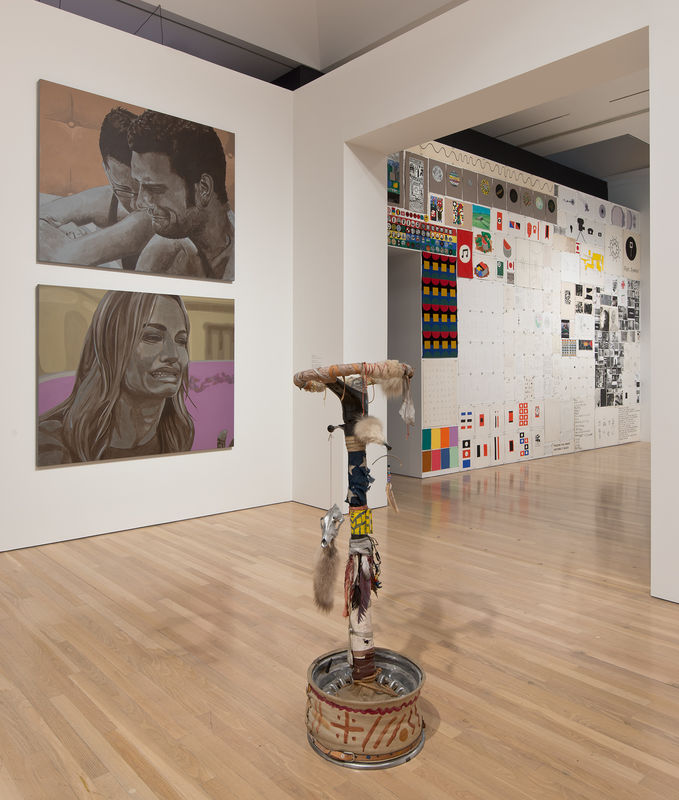
Jimmie Durham
Born in Washington, Arkansas, Jimmie Durham studied at the École des Beaux-Arts in Geneva in the late 1960s and early 1970s. In 1973 Durham, who is of Cherokee descent, returned to the United States, where he joined the American Indian Movement (AIM), eventually becoming director of the International Indian Treaty Council and a representative to the United Nations. Amid increasing fragmentation within AIM, he left the group in 1979, opting to put his politically driven energies toward visual art and poetry. As a protest against the ongoing mistreatment of Native Americans by the US government, he left the country in 1987 for Cuernavaca, Mexico; moved to Europe in the mid-1990s; and has since refused to return to the United States. Durham's artworks, essays, and poems engage themes of authenticity, cultural construction, identity, and racism while examining ideologies embedded in art and architecture and the institutionalization of nationality, religion, and science.
In Bedia's Stirring Wheel (1985), a branch from a birch tree connects the center and neck of an automobile's wheel and steering wheel in what appears to be a totemic structure that is also reminiscent of an animal. The outside of the wheel is painted with graphic symbols, and the branch and steering wheel are wrapped in bits of leather as well as a piece of an American flag. An animal skull and tail hang from the gearshift. Purposefully using materials that are stereotypical signifiers of "authentic" Native American art, Durham incorporates beads, feathers, fur, and leather into the composition. As a writer and artist whose work explores how objects reflect the knowledge and values of a culture, Durham embraces narrative, and his works often include text. A caption accompanying the sculpture reads: "José Bedia, the famous explorer/archaeologist, discovered this stirring wheel, sometimes referred to as the 'Fifth' or 'Big' wheel, during his second excavation of the ruins at White Planes in 3290 AD. He believes that the stirring wheel was a symbol for the office of the Great White Father, often called 'The Man Behind the Wheel.' Bedia claims that the chief would stand behind the wheel to make pronouncements and stirring speeches."

The fictional character José Bedia is an archaeologist in the deep future. Named after Durham's friend José Bedia, a Cuban artist who is a lifelong scholar of indigenous cultures, Bedia is a proxy who can stand in for colonialists, ethnographers, and archaeologists of the past. In texts accompanying the artworks in this series, Durham paints Bedia as an earnest explorer, all the better to parody "discoveries" and unintentional misinterpretations of artifacts and cultural activities. By setting Bedia's adventures in the future, Durham borrows the language of science fiction, taking a critical position in relation to the past but also to the present, suggesting that questionable ethnographic practices continue unchecked.
In Coyote/Trickster (1991) Durham again employs animism, organic materials, and iconography often used to signify "genuine" Native American art. Representing a trickster figure in many cultures, the coyote is a recurring image for Durham, who has himself been called a trickster for his humor and wit. The slash in the title suggests the interchangeable nature of the coyote and the trickster. While Durham's long-standing use of materials like stone, wood, animal skulls, and leather is in part a playful push against what is expected of him as a native artist, he has a deep and abiding love of these materials, a respect for their past lives, and a desire to give them new meaning.
Collected Stones (2002), made with collaborator Maria Thereza Alves (b. 1961), shows Durham engaged in actions involving stones and rocks, which have figured prominently in a number of his recent works. As a material used for making buildings, monuments, sculptures, and tools across cultures, stone is richly metaphoric, simultaneously generic and symbolic. In the various short videos, Durham uses heavy rocks to crush walnuts, clocks, and canned tomatoes, among other things. A large rock falls from above, smashing a dining table. A small handmade boat eventually sinks after being put to sea with a small boulder as its cargo. After fashioning a club out of a rock, a dowel, and a length of rope, Durham proceeds to smash in the television that had previously been broadcasting a how-to program showing the construction of the club. In an especially poignant segment, he "stones" a white refrigerator—as one would a religious martyr—in the middle of a European town square. Although there is a measure of violence in these pieces, they are also sardonic and funny, like a game of rock-paper-scissors in which the rock always wins.
—Corrina Peipon


